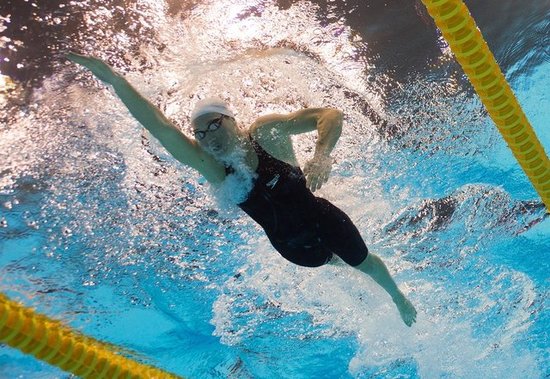The rub with swimming is that it can be the most time-intensive sport from a training perspective, but it also is the most time-intensive from an investment perspective. Very few of us has a pool in our yards or a flume in our basement, so to work out we generally have to drive to the pool and at some of the worst hours of the day – either at 0-dark-30 in the wee hours of the morning or after work in the evening when all we want to do is go home and start relaxing.
Triathletes who are top swimmers typically swam from an early age through high school and even through college. As a pure swimmer from age 5 – 21, I can tell you that as early as age 6, I was swimming twice a day in the summers, 6 days a week. And, in high school, the double workouts extended another 3 months into the high school season. Some ghastly workouts I can recall are things like 10x200m butterfly at age 11; countless 5km straight for time; 10x400IM in college; you get the picture. During weeks of double sessions, we would consistently put in 70-100km per week. In other words, as much as many runners. All this volume led to unparalleled cardiovascular fitness and stroke efficiencies that 10km per week across 3 swim workouts simply cannot touch. Swimmers’ strokes rarely breakdown the way triathletes’ strokes will because pure swimmers can handle a lot more volume and load whereas triathletes will tend to tighten up and their technique will fall apart due to the onset of fatigue and lactate build up.
So, while I could tell you that putting more time in the pool can be a surefire way to improve, that’s not what I’m going to say here. Instead, let’s answer the REAL question being asked by triathletes frustrated with their lack of swim progress, which is this: “How can I get faster at swimming without putting any more pool time?”
One nearly guaranteed way is to take your distance sets of 2,000-4,000 yards or meters and break them up into smaller increments. Rather than doing, say, 5x400 at Ironman target pace, complete 20x100 or 40x50. By shortening up the length of the reps, you will better preserve your technique and hold your stroke longer. This helps you practice better form for longer, creating positive muscle memory. With reps of shorter length comes shorter rest intervals, so there is little negative impact to the cardiovascular benefits that are typically reserved for the super long workouts or straight swims. Now, long reps have their place, too. I’m not suggesting you never do them. But, think of them as strength sessions best used in the Winter. For the above example of 5x400, put the pull buoy between your legs and paddles on your hands to create more load on the upper body. Focus on the stroke and technique rather than speed – save that for when your rep length shortens and you need to be more metronomic with both your stroke and speed.
The workout needs to be at least 45 minutes in length without extended breaks to elicit a nice cardiovascular boost. Even better, the main set needs to be this long. Not of every workout, but certainly of your key workouts and at least once per week. Twice would be better, especially in your final run-up to your key race(s).
Another way is to remain focused when you’re in the pool. It never ceases to amaze me just how inefficiently Masters workouts are generally run. There is so much time wasted standing at the side of the pool, or socializing before jumping in to start a workout, or during kick sets, and so on. Directly out of college, I coached high school girls and boys swimming for 3 years. I broke my teams into various squads based on skill, stroke specialty, and distance vs middle distance vs sprint depending on what the focus was for the day’s workout. I calculated sets so that each group would end its set at almost precisely the same time as every other group so that we could move forward through the workout together and minimize all the wasted time. It worked to great effect.
Making the above adjustments will most definitely pay dividends in your swim training without making you train any longer or more frequently. By being more focused, you will get more out of the time you do put into the pool and, I reckon, you will swim faster come your 2017 key races.
Happy Training,
Coach Nate



 RSS Feed
RSS Feed